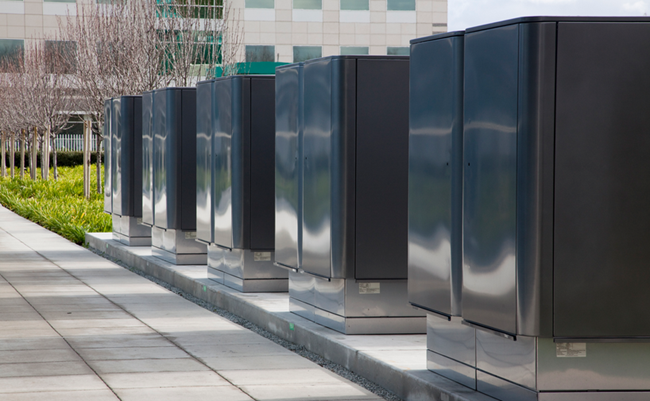.
One Thing Is Certain The Old Energy Distribution Model Has Been Broken
For a century power has been generated at central locations and then distributed by the grid to the nation.
But that is changing with the focus on renewable energy sources and new battery and other energy storage solutions.
Johannes Teyssen, E.ON’s Chief Executive, has been quoted as saying that the traditional business model for utilities has ‘broken apart’. He cited the main reason for this change as being technology, which has lowered the barrier of entry to the energy market, hence undermining the traditional role of the utility.
Phil Caldwell – CEO of Ceres Power, UK the author of the original article being quoted here see fuel cells as one of those disruptive technologies.

Image Source – Bloom Energy
Disruptive technology
Fuel cells are one of the disruptive technologies that, at the right cost point, can enable a further shift towards highly efficient distributed generation.
Used in distributed energy products, fuel cells offer consumers the ability to generate power efficiently in their homes and businesses, giving them more control over their energy use while reducing demands on the electricity grid, and easing the strain on grid stability and the ageing infrastructure.
By generating power at efficiencies of around 50% at the point of use, with no transmission and distribution (T&D) losses – and 90% if operating as a combined heat and power (CHP) system – fuel cells can provide a tipping point for distributed generation, by generating power more reliably, efficiently, and at lower cost to the grid.
Recent studies in the EU have shown that fuel cell CHP systems save 27% of a typical home’s energy consumption, 30% of its CO2emissions, and eliminate other pollutants such as NOx almost entirely.[1] If every home or business owner could generate the power they need, combined with the ability to reduce their energy bills and carbon emissions by at least 25%, then surely this game-changing technology will achieve mass adoption?
The shift towards distributed generation
So how is the shift towards distributed power generation playing out around the world?
Japan and South Korea, which depend on imports for over 90% of their primary energy demand[2] and are the world’s biggest importers of liquefied natural gas (LNG),[3] are leading the way in fuel cell commercialisation. They are closely followed by the US, as it moves towards energy independence based on its plentiful shale gas reserves.
By the end of 2014 the number of fuel cell micro CHP (mCHP) systems installed in Japan had reached 138 000, and the Japanese government has a target to have 1 million homes powered by fuel cells by 2020, and 5 million homes by 2030.
Progress in US and Germany
In the US, centralised generation is now expected to produce less power in 2015 than it did in 2007, despite significant economic growth, due to the combined impact of energy efficiency and distributed generation. This backward trend is without precedent in recent history.
Unreliable power supply cost the US economy an eye-watering $150 billion in 2013,[4] and companies are inevitably looking for solutions to ensure the reliability of supply to their businesses. Generous state and federal subsidies have encouraged the adoption of MW-scale fuel cell installations, and companies such as eBay, Google and Apple are already deploying fuel cells for power generation to ensure security of supply to their mission-critical data centres.
What about Europe? Germany provides the most supportive policy and subsidy structure for fuel cell development. Extensive uptake of wind and solar renewables has left the German electricity grid struggling to balance power outputs, and to secure low-carbon, flexible energy supplies the government has given its support to fuel cell mCHP.
Read more about the fuel cell disruption in the original article.



